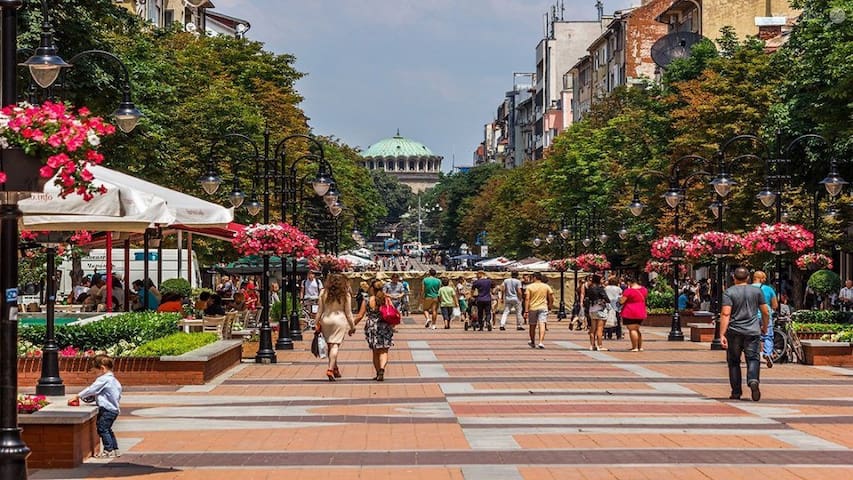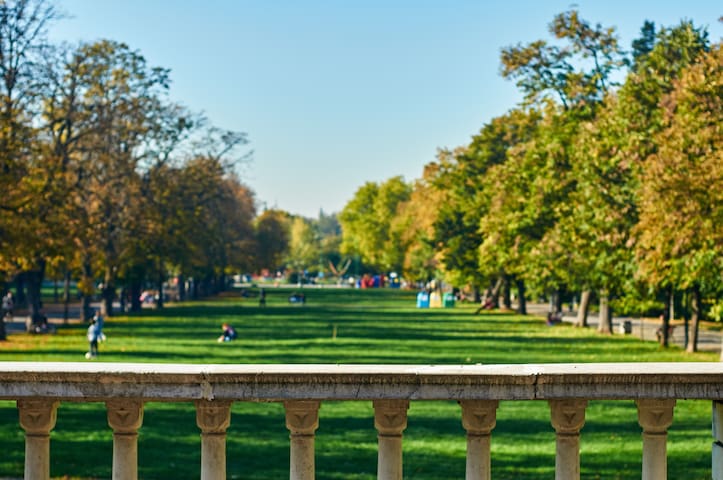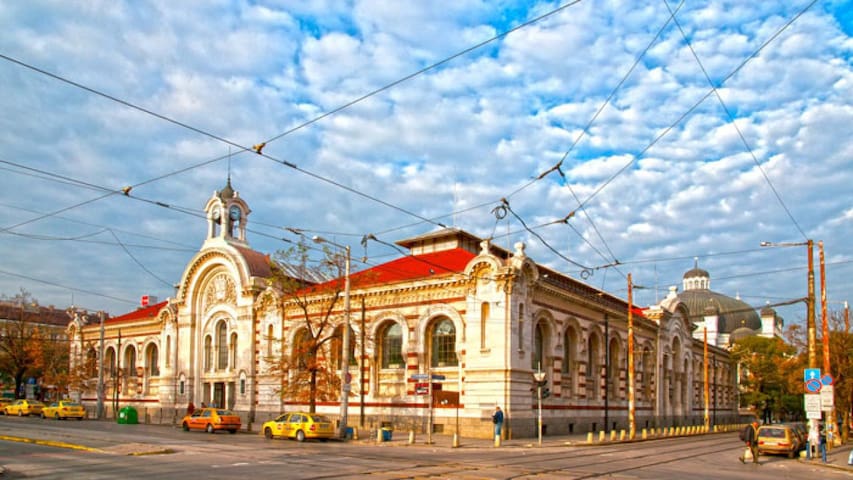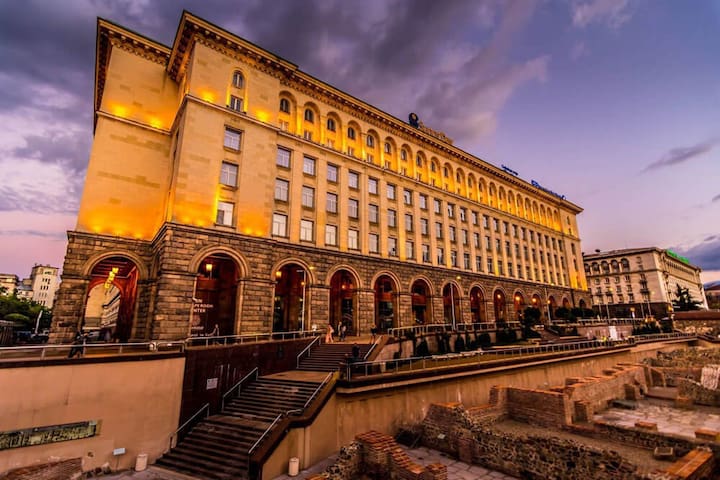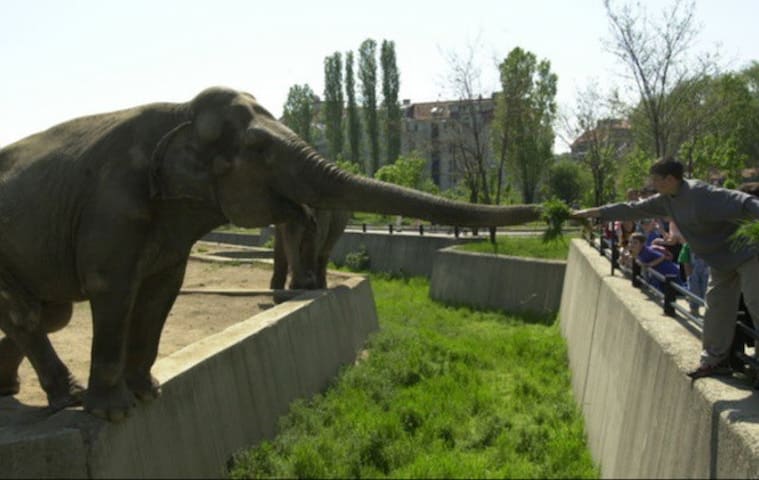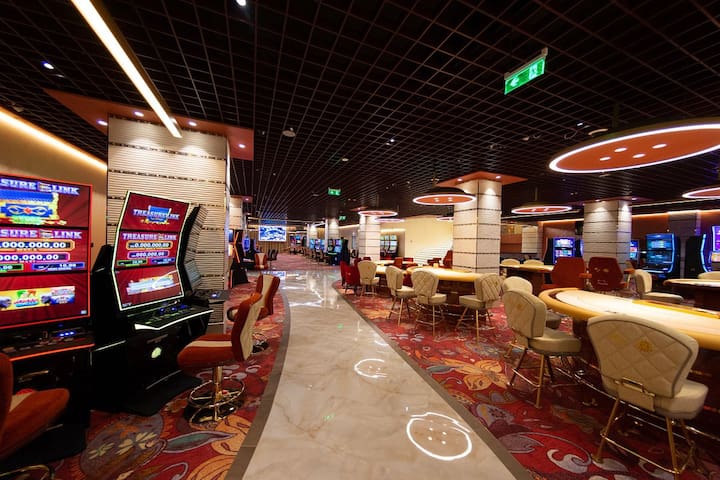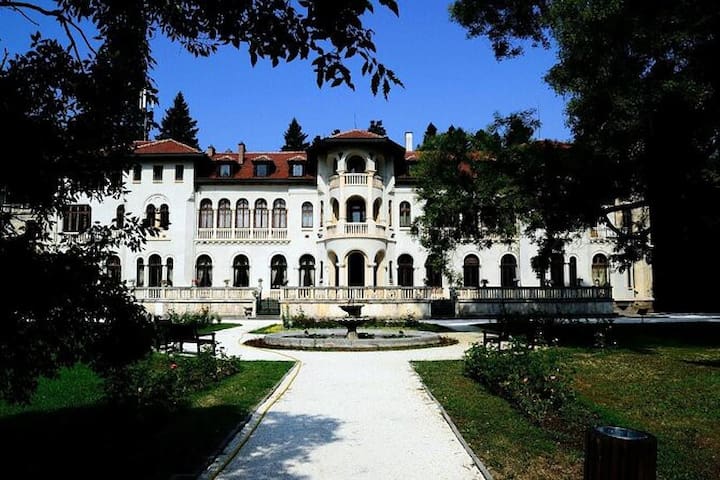Sightseeing
The Patriarchal Cathedral of St. Alexander Nevski is the largest Orthodox temple on the entire Balkan Peninsula.
By its size and decoration, by its architecture and monumentality the temple St. Alexander Nevsky can compete with the most famous monuments of this type all over the world.
Viewed from the outside, the length of the temple is 72 meters, and the width is 55 meters. Its height is 50.52 meters and the roof bridge is 28 meters above the main vaulted entrance with three doors and a bell tower that ends with a dome. It is supported by three columns, between which there are wide openings and through which you can see the 12 bells.
369 当地人推荐
圣亚历山大涅夫斯基大教堂
ploshtad "Sveti Aleksandar Nevski"The Patriarchal Cathedral of St. Alexander Nevski is the largest Orthodox temple on the entire Balkan Peninsula.
By its size and decoration, by its architecture and monumentality the temple St. Alexander Nevsky can compete with the most famous monuments of this type all over the world.
Viewed from the outside, the length of the temple is 72 meters, and the width is 55 meters. Its height is 50.52 meters and the roof bridge is 28 meters above the main vaulted entrance with three doors and a bell tower that ends with a dome. It is supported by three columns, between which there are wide openings and through which you can see the 12 bells.
Vitosha Boulevard is the main commercial street in the centre of Sofia, the capital of Bulgaria, which is abundant in posh stores, restaurants and bars.
21 当地人推荐
bulevard "Vitosha"
bulevard "Vitosha"Vitosha Boulevard is the main commercial street in the centre of Sofia, the capital of Bulgaria, which is abundant in posh stores, restaurants and bars.
This church is the direct successor of several smaller churches from medieval times.The theories say that in the beginning the church was built by wood and it had fundamentials made of stone. Later on the entire church was built by stone. But in 1925 it was destroyed by a bomb blast assassination attempt on Tsar Boris III. In this terrorist act set by the comunists. Over 200 people were killed, although the intended victim was spared. The current architecture and design date back to 1950 when the Comunist party decided to restore the church and rename it to Sveta Nedelya.
108 当地人推荐
圣基里亚基大教堂
20 pl. "Sveta Nedelya"This church is the direct successor of several smaller churches from medieval times.The theories say that in the beginning the church was built by wood and it had fundamentials made of stone. Later on the entire church was built by stone. But in 1925 it was destroyed by a bomb blast assassination attempt on Tsar Boris III. In this terrorist act set by the comunists. Over 200 people were killed, although the intended victim was spared. The current architecture and design date back to 1950 when the Comunist party decided to restore the church and rename it to Sveta Nedelya.
The Church of St. Sofia is situated in the center of Bulgaria’s capital. Like its namesake, Hagia Sophia in Constantinople, it was originally dedicated to the wisdom of God. It is one of the oldest churches in Sofia and its history is closely related to the history of the city. In fact, Sofia is named after this church.
It is likely the site of the Council of Serdica held in Sofia in 343. While it was upheld in the East and the West, this council did not accomplish its goals, and thus is not viewed as an ecumenical council as, for example, the Council of Nicea would be.
80 当地人推荐
St. Sophia Church
2 ul. "Paris"The Church of St. Sofia is situated in the center of Bulgaria’s capital. Like its namesake, Hagia Sophia in Constantinople, it was originally dedicated to the wisdom of God. It is one of the oldest churches in Sofia and its history is closely related to the history of the city. In fact, Sofia is named after this church.
It is likely the site of the Council of Serdica held in Sofia in 343. While it was upheld in the East and the West, this council did not accomplish its goals, and thus is not viewed as an ecumenical council as, for example, the Council of Nicea would be.
The Russian Church is officially known as the Church of St Nicholas the Miracle-Maker.
Fun fact: Inside the church you can leave notes with wishes next to the holy remains of St Nicholas, which are likely to be fulfilled, at least that is what is believed.
104 当地人推荐
俄罗斯教堂“斯韦蒂·尼古拉·米尔利基伊斯基”
3 bul. "Tsar Osvoboditel"The Russian Church is officially known as the Church of St Nicholas the Miracle-Maker.
Fun fact: Inside the church you can leave notes with wishes next to the holy remains of St Nicholas, which are likely to be fulfilled, at least that is what is believed.
The oldest and best-preserved monument of architecture since Roman times in Sofia is the rotunda church St. George. It was built in the beginning of the 4th century AD during the reign of the Roman emperor Constantine the Great (reigned 306 – 337) and the flourishing of the ancient town Serdika (the old name of Sofia). It is believed that the rotunda is the oldest building in Sofia.
At the time of Emperor Justinian the Great (reigned 527 – 565), the Rotunda was transformed into a church. The first wall painting was made in the same period. It is assumed that since then it bears the name of St. George the Martyr, who suffered for his faith in Minor Asia in the 3rd century, under the reign of Emperor Diocletian (reigned 284 – 305).
74 当地人推荐
圣乔治旋转教堂
2 bul. Kniaz Aleksandar DondukovThe oldest and best-preserved monument of architecture since Roman times in Sofia is the rotunda church St. George. It was built in the beginning of the 4th century AD during the reign of the Roman emperor Constantine the Great (reigned 306 – 337) and the flourishing of the ancient town Serdika (the old name of Sofia). It is believed that the rotunda is the oldest building in Sofia.
At the time of Emperor Justinian the Great (reigned 527 – 565), the Rotunda was transformed into a church. The first wall painting was made in the same period. It is assumed that since then it bears the name of St. George the Martyr, who suffered for his faith in Minor Asia in the 3rd century, under the reign of Emperor Diocletian (reigned 284 – 305).
"Ivan Vazov" National Theatre is the earliest and the most authoritative of Bulgarian stages, having a rich history, firmly anchored in its traditions, with a commanding and protean presence in the modernity of the present. The theatre offers a broad repertoire of both contemporary and classical plays appealing to the widest possible range of audiences.
Presently, the National Theatre is the most significant and representative Bulgarian theatrical institution with its three stages, a permanent theatre company and a rich repertoire staging ten or so premieres per season.
276 当地人推荐
伊万·瓦佐夫国家剧院
5 ul. "Dyakon Ignatiy""Ivan Vazov" National Theatre is the earliest and the most authoritative of Bulgarian stages, having a rich history, firmly anchored in its traditions, with a commanding and protean presence in the modernity of the present. The theatre offers a broad repertoire of both contemporary and classical plays appealing to the widest possible range of audiences.
Presently, the National Theatre is the most significant and representative Bulgarian theatrical institution with its three stages, a permanent theatre company and a rich repertoire staging ten or so premieres per season.
The National Archaeological Institute with Museum at the Bulgarian Academy of Sciences covers the complete study of the culture of tribes and peoples who have occupied present day Bulgaria from the remote past until the 18th century. NAIM-BAS is a national center and coordinator of all field research in Bulgaria and exercises scholarly and methodological control on it. The Museum of Archaeology hosts the most numerous collections in Bulgaria and its exhibitions reveal it as one of the most important centers in the country for promotion of the cultural heritage of present day Bulgaria.
The Buyuk (Grand) mosque (museum building) is the oldest building of its kind in Sofia. Its building inscription hasn’t survived, but according to some written records it was named Kodzha Mahmud Pasha dzhamisi, i.e., the mosque of the great Mahmud Pasha. A complex of many buildings surrounded the mosque as it was the Ottoman construction tradition.
47 当地人推荐
Archeological Museum
площад „Атанас Буров“The National Archaeological Institute with Museum at the Bulgarian Academy of Sciences covers the complete study of the culture of tribes and peoples who have occupied present day Bulgaria from the remote past until the 18th century. NAIM-BAS is a national center and coordinator of all field research in Bulgaria and exercises scholarly and methodological control on it. The Museum of Archaeology hosts the most numerous collections in Bulgaria and its exhibitions reveal it as one of the most important centers in the country for promotion of the cultural heritage of present day Bulgaria.
The Buyuk (Grand) mosque (museum building) is the oldest building of its kind in Sofia. Its building inscription hasn’t survived, but according to some written records it was named Kodzha Mahmud Pasha dzhamisi, i.e., the mosque of the great Mahmud Pasha. A complex of many buildings surrounded the mosque as it was the Ottoman construction tradition.
The National Military History Museum is a museum dedicated to military history in Sofia, Bulgaria. A structure of the Ministry of Defence, it has existed under various names and subordinate to various institutions since 1 August 1914.
Fun Fact: The Bulgarian army has never lost a single flag in battle.
34 当地人推荐
National Museum of Military History
92 ul. "Cherkovna"The National Military History Museum is a museum dedicated to military history in Sofia, Bulgaria. A structure of the Ministry of Defence, it has existed under various names and subordinate to various institutions since 1 August 1914.
Fun Fact: The Bulgarian army has never lost a single flag in battle.
The National Palace of Culture is the largest, multifunctional conference and exhibition centre in south-eastern Europe. It was opened in 1981 in celebration of Bulgaria's 1300th anniversary.
182 当地人推荐
国家文化宫公园
Bulevard "Bulgaria"The National Palace of Culture is the largest, multifunctional conference and exhibition centre in south-eastern Europe. It was opened in 1981 in celebration of Bulgaria's 1300th anniversary.
The museum includes a cloakroom, cafe, library and souvenir shop. It undertakes professional conservation and restoration of historical monuments, authenticity investigations and expert valuation. Its collections comprise materials dating from prehistoric ages till the present.
Major excavated exhibits include:
Valchitran Treasure
Dabene Treasure
Rogozen Treasure (part)
Panagyurishte Treasure (either replicas or the real objects)
111 当地人推荐
National Museum of History
16 ul. "Vitoshko lale"The museum includes a cloakroom, cafe, library and souvenir shop. It undertakes professional conservation and restoration of historical monuments, authenticity investigations and expert valuation. Its collections comprise materials dating from prehistoric ages till the present.
Major excavated exhibits include:
Valchitran Treasure
Dabene Treasure
Rogozen Treasure (part)
Panagyurishte Treasure (either replicas or the real objects)
The City Garden is Sofia's oldest and most central public garden, in existence since 1872. Today the City Garden is not only a popular retreat for the residents of the capital, but also a favoured place for amateur chess players, who can be regularly seen in the small garden in front of the National Theatre. It was also the place where a group of around 300 people gathered on 27 August 1895 to climb Cherni vrah in Vitosha led by the writer Aleko Konstantinov on what is regarded as the birth date of tourism in Bulgaria.
64 当地人推荐
城市花园
The City Garden is Sofia's oldest and most central public garden, in existence since 1872. Today the City Garden is not only a popular retreat for the residents of the capital, but also a favoured place for amateur chess players, who can be regularly seen in the small garden in front of the National Theatre. It was also the place where a group of around 300 people gathered on 27 August 1895 to climb Cherni vrah in Vitosha led by the writer Aleko Konstantinov on what is regarded as the birth date of tourism in Bulgaria.
Borisova gradina or Knyaz-Borisova gradina is the oldest and best known park in Sofia. Its construction and arrangement began in 1884 and it is named after Bulgarian Tsar Boris III.
120 当地人推荐
Borisova Gradina
Borisova gradina or Knyaz-Borisova gradina is the oldest and best known park in Sofia. Its construction and arrangement began in 1884 and it is named after Bulgarian Tsar Boris III.
Entering the Red Flat means traveling back in time to Communist Bulgaria of the 1980’s. By visiting the home of an average family you will discover what everyday life was like for ordinary Bulgarians during the Cold War. Work and leisure, school and vacation, eating, drinking, watching TV, partying and doing the chores - how did these things happen in the days of Reagan and Gorbachev? Enter the flat and find out for yourselves!
7 当地人推荐
The Red Flat - Everyday Life in Communist Bulgaria
24 улица „Иван Денкоглу“Entering the Red Flat means traveling back in time to Communist Bulgaria of the 1980’s. By visiting the home of an average family you will discover what everyday life was like for ordinary Bulgarians during the Cold War. Work and leisure, school and vacation, eating, drinking, watching TV, partying and doing the chores - how did these things happen in the days of Reagan and Gorbachev? Enter the flat and find out for yourselves!
The Sofia Synagogue is the largest synagogue in Southeastern Europe, one of two functioning in Bulgaria and the third-largest in Europe.
54 当地人推荐
Sofia Synagogue
16 Exarch Joseph StreetThe Sofia Synagogue is the largest synagogue in Southeastern Europe, one of two functioning in Bulgaria and the third-largest in Europe.
Regional History Museum – Sofia is located in one of the most beautiful and emblematic buildings of the capital city – the former Central Mineral Bathhouse, built in 1912. It is known among the residents of the city as the “Museum of Sofia”.
78 当地人推荐
索非亚地区历史博物馆
1 Platno.„Banski"Regional History Museum – Sofia is located in one of the most beautiful and emblematic buildings of the capital city – the former Central Mineral Bathhouse, built in 1912. It is known among the residents of the city as the “Museum of Sofia”.
Museum with artworks based on optical illusions & interactive spaces popular for taking photos.
10 当地人推荐
索非亚幻觉博物馆
16 булевард „кн. Мария Луиза“Museum with artworks based on optical illusions & interactive spaces popular for taking photos.
The Museum of Socialist Art in Sofia is a museum of art which covers the history of the communist era in Bulgaria. The museum, a branch of the national art gallery, has a display of socialist regime of 45 years (1944–89) period of art symbols and other artifacts and archives with statues in the park.
29 当地人推荐
社会主义艺术博物馆
7 ul. "Lachezar Stanchev"The Museum of Socialist Art in Sofia is a museum of art which covers the history of the communist era in Bulgaria. The museum, a branch of the national art gallery, has a display of socialist regime of 45 years (1944–89) period of art symbols and other artifacts and archives with statues in the park.
Kvadrat 500, the newest and largest building of the National Gallery, opened on 25 May 2015. Some 1,700 artworks from the gallery’s rich fund of over 42,000 museum pieces by Bulgarian and foreign artists are exhibited in 28 halls on four levels. The Bulgarian collection dates back to the 1890s, while the greater part of the foreign collection was formed in the 1980s. The exposition features works tracing the path of Bulgarian art from the mid-19th century and from the 20th century, European art from the 15th–19th centuries, and art exhibits from Asia, Africa, and America.
53 当地人推荐
National Gallery
1 ul. "19-ti fevruari"Kvadrat 500, the newest and largest building of the National Gallery, opened on 25 May 2015. Some 1,700 artworks from the gallery’s rich fund of over 42,000 museum pieces by Bulgarian and foreign artists are exhibited in 28 halls on four levels. The Bulgarian collection dates back to the 1890s, while the greater part of the foreign collection was formed in the 1980s. The exposition features works tracing the path of Bulgarian art from the mid-19th century and from the 20th century, European art from the 15th–19th centuries, and art exhibits from Asia, Africa, and America.
The mosque was designed by the famous Ottoman architect Mimar Sinan and completed in 1566, during the years the Ottomans had control of the city. The mosque derives its name from the phrase Banya Bashi, which means many baths. (In the Turkish language Banyo means bath and Baş pronounced Bash means 'head' or 'main', so looking at the location it is built on, a more logical translation of the name would be 'Head of the bath mosque') The most outstanding feature of the mosque is that it was actually built over natural thermal spas; one can even see the steam rising from vents in the ground near the mosque walls. The mosque is famous for its large dome, diameter 15m, and the minaret.
45 当地人推荐
Banya Bashi Mosque
18 булевард „кн. Мария Луиза“The mosque was designed by the famous Ottoman architect Mimar Sinan and completed in 1566, during the years the Ottomans had control of the city. The mosque derives its name from the phrase Banya Bashi, which means many baths. (In the Turkish language Banyo means bath and Baş pronounced Bash means 'head' or 'main', so looking at the location it is built on, a more logical translation of the name would be 'Head of the bath mosque') The most outstanding feature of the mosque is that it was actually built over natural thermal spas; one can even see the steam rising from vents in the ground near the mosque walls. The mosque is famous for its large dome, diameter 15m, and the minaret.
The Museum's collection includes over 400 stuffed mammals, over 1,200 species of birds, hundreds of thousands of insects and other invertebrates, as well as samples of about one quarter of the world's mineral species.
53 当地人推荐
National Museum of Natural History
1 bul. "Tsar Osvoboditel"The Museum's collection includes over 400 stuffed mammals, over 1,200 species of birds, hundreds of thousands of insects and other invertebrates, as well as samples of about one quarter of the world's mineral species.
The Sveti Sedmochislenitsi Church and formerly The Black Mosque is a Bulgarian Orthodox church in Sofia. It was created between 1901 and 1902 as an Ottoman mosque later converted into orthodox Church, and was inaugurated on 27 July 1903.
26 当地人推荐
Sveti Sedmochislenitsi Church
25 ul. "Graf Ignatiev"The Sveti Sedmochislenitsi Church and formerly The Black Mosque is a Bulgarian Orthodox church in Sofia. It was created between 1901 and 1902 as an Ottoman mosque later converted into orthodox Church, and was inaugurated on 27 July 1903.
The Church of St Paraskeva is a Bulgarian Orthodox church in Sofia. It is the third-largest church in Sofia. St Paraskeva has a somewhat unusual design for an Eastern Orthodox church. For example, the cella is in practice a round chamber over 20 metres (66 ft) in diameter. The cella gradually disintegrates into the surrounding apses.
圣帕拉斯凯娃教堂
58 ulitsa „Georgi S. Rakovski“The Church of St Paraskeva is a Bulgarian Orthodox church in Sofia. It is the third-largest church in Sofia. St Paraskeva has a somewhat unusual design for an Eastern Orthodox church. For example, the cella is in practice a round chamber over 20 metres (66 ft) in diameter. The cella gradually disintegrates into the surrounding apses.
The Central Sofia Market Hall, known popularly simply as The Market Hall is a covered market in the centre of Sofia, located on Marie Louise Boulevard. It was opened in 1911 and is today an important trade centre in the city. The style of the building, which is regarded as Torbov's best work,[2] is Neo-Renaissance, featuring also elements of Neo-Byzantine architecture and Neo-Baroque. The façade is known for its relief of the coat of arms of Sofia above the main entrance created by the artist Haralampi Tachev. The famous little clock tower with three dials tops the edifice. The building was originally constructed with four entrances, though not all are used today.
73 当地人推荐
索非亚中央市场大厅
25 булевард „кн. Мария Луиза“The Central Sofia Market Hall, known popularly simply as The Market Hall is a covered market in the centre of Sofia, located on Marie Louise Boulevard. It was opened in 1911 and is today an important trade centre in the city. The style of the building, which is regarded as Torbov's best work,[2] is Neo-Renaissance, featuring also elements of Neo-Byzantine architecture and Neo-Baroque. The façade is known for its relief of the coat of arms of Sofia above the main entrance created by the artist Haralampi Tachev. The famous little clock tower with three dials tops the edifice. The building was originally constructed with four entrances, though not all are used today.
Both old legends and contemporary tips share one thing in common – the Women’s Market (also referred to as the Ladies’ Market, Ladies’ Bazaar and Zhenski Pazar) is the must-visit colorful, lively and fragrant spot in the heart of Sofia. Established right after Bulgaria’s Liberation from Ottoman rule in 1878, the Women’s market is the oldest open-air market in town.
39 当地人推荐
女人市场
bulevard "Stefan Stambolov"Both old legends and contemporary tips share one thing in common – the Women’s Market (also referred to as the Ladies’ Market, Ladies’ Bazaar and Zhenski Pazar) is the must-visit colorful, lively and fragrant spot in the heart of Sofia. Established right after Bulgaria’s Liberation from Ottoman rule in 1878, the Women’s market is the oldest open-air market in town.
The Central Department Store is an upmarket department store in the centre of Sofia, officially opened in 1957 and situated in a monumental edifice on one of the city's main boulevards. The store's construction began in 1955 and ended in the end of 1956, when the first customers entered TZUM.
24 当地人推荐
TZUM
2 булевард „кн. Мария Луиза“The Central Department Store is an upmarket department store in the centre of Sofia, officially opened in 1957 and situated in a monumental edifice on one of the city's main boulevards. The store's construction began in 1955 and ended in the end of 1956, when the first customers entered TZUM.
The Earth and Man National Museum is a mineralogical museum in the centre of Sofia. It's one of the biggest mineralogical museums in the world. Apart from its permanent expositions related to mineral diversity, the museum also often hosts exhibitions connected with various other topics as well as concerts of chamber music.
34 当地人推荐
地球与人民国家博物馆
4 bulevard "Cherni vrah"The Earth and Man National Museum is a mineralogical museum in the centre of Sofia. It's one of the biggest mineralogical museums in the world. Apart from its permanent expositions related to mineral diversity, the museum also often hosts exhibitions connected with various other topics as well as concerts of chamber music.
Ancient cultural and communication complex “Serdica” combines areas with various purposes, divided into two zones. The “Largo” zone, situated underneath Nezavisimost Square, integrates the unearthed archaeological remains into a site for cultural events. The remains of one of the two main streets of the Roman town, the decumanus maximus, which connects the eastern and the western gate of the city, can be seen here. A large residential building, covering an entire insula (urban block), can be seen south of it. The building also had small shops, from which travelers and the town’s inhabitants could purchase food and various goods.
16 当地人推荐
Complex Ancient Serdica
5 ul. "Serdika"Ancient cultural and communication complex “Serdica” combines areas with various purposes, divided into two zones. The “Largo” zone, situated underneath Nezavisimost Square, integrates the unearthed archaeological remains into a site for cultural events. The remains of one of the two main streets of the Roman town, the decumanus maximus, which connects the eastern and the western gate of the city, can be seen here. A large residential building, covering an entire insula (urban block), can be seen south of it. The building also had small shops, from which travelers and the town’s inhabitants could purchase food and various goods.
The Statue of Sveta Sofia is a monumental sculpture in Sofia, Bulgaria. The statue, erected in 2000, stands in a spot once occupied by a statue of Lenin. Sophia was considered too erotic and pagan to be referred to as a saint.
30 当地人推荐
Saint Sofia Monument
The Statue of Sveta Sofia is a monumental sculpture in Sofia, Bulgaria. The statue, erected in 2000, stands in a spot once occupied by a statue of Lenin. Sophia was considered too erotic and pagan to be referred to as a saint.
The National Assembly is the unicameral parliament and legislative body of the Republic of Bulgaria. The National Assembly was established in 1879 with the Tarnovo Constitution.
National Assembly building
2 Knyaz Alexander Dondukov BoulevardThe National Assembly is the unicameral parliament and legislative body of the Republic of Bulgaria. The National Assembly was established in 1879 with the Tarnovo Constitution.
The monument commemorates the hundreds of thousands of Bulgarian soldiers who died in wars defending their homeland. It features an eternal flame, turf from Stara Zagora and Shipka Pass, sites of two of the most important battles of the Russo-Turkish War of Liberation (the Battle of Stara Zagora and the Battle of Shipka Pass) and a sculpture of a lion (a national symbol of Bulgaria)
6 当地人推荐
Monument of the Unknown Soldier
4 ul. "Oborishte"The monument commemorates the hundreds of thousands of Bulgarian soldiers who died in wars defending their homeland. It features an eternal flame, turf from Stara Zagora and Shipka Pass, sites of two of the most important battles of the Russo-Turkish War of Liberation (the Battle of Stara Zagora and the Battle of Shipka Pass) and a sculpture of a lion (a national symbol of Bulgaria)
Founded on 1 October 1888, the edifice of the university was constructed between 1924 and 1934 with the financial support of the brothers Evlogi Georgiev and Hristo Georgiev (whose sculptures are now featured on its façade) and has an area of 18,624 m² and a total of 324 premises. The university has 16 faculties and three departments, where over 21,000 students receive their education. It has been consistently ranked as the top university in Bulgaria according to national and international rankings, being constantly among the best four percent of world universities.
99 当地人推荐
Sofia University St. Kliment Ohridski
15 bul. "Tsar Osvoboditel"Founded on 1 October 1888, the edifice of the university was constructed between 1924 and 1934 with the financial support of the brothers Evlogi Georgiev and Hristo Georgiev (whose sculptures are now featured on its façade) and has an area of 18,624 m² and a total of 324 premises. The university has 16 faculties and three departments, where over 21,000 students receive their education. It has been consistently ranked as the top university in Bulgaria according to national and international rankings, being constantly among the best four percent of world universities.
The main aims of SS. Cyril and Methodius National Library since its establishment was to collect manuscripts, old printed books, and all books in Bulgarian language or by Bulgarian authors written in a foreign language. Later a fund of Slavic and foreign language manuscripts was formed. Among the first entries were the rich personal libraries of the historian Prof. Marin Drinov and the poet Petko Slaveikov, as well as collections from different churches and monasteries. Two collections were formed in the National Library – consisting of Bulgarian and of Oriental documents respectively. Since its very beginning, the institution acquired the character of historical archives.
42 当地人推荐
圣西里尔和圣方法国家图书馆
bulevard "Vasil Levski"The main aims of SS. Cyril and Methodius National Library since its establishment was to collect manuscripts, old printed books, and all books in Bulgarian language or by Bulgarian authors written in a foreign language. Later a fund of Slavic and foreign language manuscripts was formed. Among the first entries were the rich personal libraries of the historian Prof. Marin Drinov and the poet Petko Slaveikov, as well as collections from different churches and monasteries. Two collections were formed in the National Library – consisting of Bulgarian and of Oriental documents respectively. Since its very beginning, the institution acquired the character of historical archives.
The park is named after the monument of the fallen medics during the Russo-Turkish War (1877–1878), most of whom worked for the mission of the Russian Red Cross and perished in the battles at Pleven, Plovdiv, Mechka and Shipka. The monument was constructed between 1883 and 1884 by the Russian architect of Czech origin Antoniy Osipovich Tomishko.
60 当地人推荐
医生花园
The park is named after the monument of the fallen medics during the Russo-Turkish War (1877–1878), most of whom worked for the mission of the Russian Red Cross and perished in the battles at Pleven, Plovdiv, Mechka and Shipka. The monument was constructed between 1883 and 1884 by the Russian architect of Czech origin Antoniy Osipovich Tomishko.
The church features a semi-cylindrical vault, a hemispherical apse, and a crypt discovered during excavations after the Second World War. The walls are 1 m thick and made from brick and stone. According to one theory, Bulgarian national hero Vasil Levski is buried in the church. Press reports from 1937 retelling the stories of those who carried out a reburial, which might have been for Levski
31 当地人推荐
圣佩特卡
The church features a semi-cylindrical vault, a hemispherical apse, and a crypt discovered during excavations after the Second World War. The walls are 1 m thick and made from brick and stone. According to one theory, Bulgarian national hero Vasil Levski is buried in the church. Press reports from 1937 retelling the stories of those who carried out a reburial, which might have been for Levski
Sofia Zoo was founded by royal decree on 1 May 1888, and is the oldest and largest zoological garden in southeastern Europe. It covers 36 hectares and, in March 2006, housed 4,850 animals representing 840 species.
45 当地人推荐
索非亚动物园
37-11 ul. "Srebarna"Sofia Zoo was founded by royal decree on 1 May 1888, and is the oldest and largest zoological garden in southeastern Europe. It covers 36 hectares and, in March 2006, housed 4,850 animals representing 840 species.
Armeets Arena Sofia is a multi-purpose indoor arena. It has a seating capacity of 12,373. For concerts it can grow to 17,906.
24 当地人推荐
Arena Armeets Sofia
1 bul. "Asen Yordanov"Armeets Arena Sofia is a multi-purpose indoor arena. It has a seating capacity of 12,373. For concerts it can grow to 17,906.
Vasil Levski National Stadium, named after Bulgarian national hero and revolutionary Vasil Levski, is the country's second largest stadium. The stadium has 43,230 seats and is located in the centre of Sofia, on the territory of the city's oldest and most famous park - the Borisova gradina. The Bulgaria national football team's home matches and the Bulgarian Cup finals are held at the venue, as well as athletics competitions. It was used as the home venue for Levski Sofia's Champions League games, and is often used for important derbies between the big clubs from Sofia, instead of their own home stadiums.
37 当地人推荐
瓦西尔·列夫斯基国家体育场
38 бул. „Евлоги и Христо Георгиеви“Vasil Levski National Stadium, named after Bulgarian national hero and revolutionary Vasil Levski, is the country's second largest stadium. The stadium has 43,230 seats and is located in the centre of Sofia, on the territory of the city's oldest and most famous park - the Borisova gradina. The Bulgaria national football team's home matches and the Bulgarian Cup finals are held at the venue, as well as athletics competitions. It was used as the home venue for Levski Sofia's Champions League games, and is often used for important derbies between the big clubs from Sofia, instead of their own home stadiums.
Georgi Asparuhov Stadium , due to sponsorship currently known as Vivacom Arena – Georgi Asparuhov, nicknamed Gerena (Bulgarian: Герена, meaning "the flood plain"), is a multi-purpose stadium situated in the Suhata reka neighbourhood of the Bulgarian capital Sofia. Named after the best Bulgarian footballer of the 20th century Georgi Asparuhov, it has been the home ground of Bulgarian association football club Levski Sofia since its opening in 1963.
The stadium's record attendance is 60,000 spectators and was achieved twice - on March 4, 1970 when Levski Sofia hosted Polish club Górnik Zabrze in an 1969-70 European Cup Winners' Cup quarter-final match and in a 1973-74 A Group fixture against Pirin Blagoevgrad on September 16, 1973.
Levski Sofia holds the Bulgarian record for the longest unbeaten run on their home stadium. Between October 1, 1966 and February 23, 1985 (18 years, 4 months and 22 days), the team was not defeated in 203 consecutive matches.
维瓦科姆·阿斯帕鲁霍夫体育场
№47 ulitsa Todorini kukliGeorgi Asparuhov Stadium , due to sponsorship currently known as Vivacom Arena – Georgi Asparuhov, nicknamed Gerena (Bulgarian: Герена, meaning "the flood plain"), is a multi-purpose stadium situated in the Suhata reka neighbourhood of the Bulgarian capital Sofia. Named after the best Bulgarian footballer of the 20th century Georgi Asparuhov, it has been the home ground of Bulgarian association football club Levski Sofia since its opening in 1963.
The stadium's record attendance is 60,000 spectators and was achieved twice - on March 4, 1970 when Levski Sofia hosted Polish club Górnik Zabrze in an 1969-70 European Cup Winners' Cup quarter-final match and in a 1973-74 A Group fixture against Pirin Blagoevgrad on September 16, 1973.
Levski Sofia holds the Bulgarian record for the longest unbeaten run on their home stadium. Between October 1, 1966 and February 23, 1985 (18 years, 4 months and 22 days), the team was not defeated in 203 consecutive matches.
Stadion Balgarska Armia - lit. ''Bulgarian Army Stadium'') is the club stadium of the Bulgarian football club CSKA Sofia. It's situated in the Borisova gradina in the centre of Sofia. The stadium has four sectors and a total of 22,995 (18,495) seats, of which 2,100 are covered.
保加利亚军队
3 bul. "Dragan Tsankov"Stadion Balgarska Armia - lit. ''Bulgarian Army Stadium'') is the club stadium of the Bulgarian football club CSKA Sofia. It's situated in the Borisova gradina in the centre of Sofia. The stadium has four sectors and a total of 22,995 (18,495) seats, of which 2,100 are covered.
Wide variety of elements - rope climbing exercises, obstacle courses and zip-lines - an outdoor activity surrounded by nature..
Kokolandia High Rope Park
Wide variety of elements - rope climbing exercises, obstacle courses and zip-lines - an outdoor activity surrounded by nature..
Palms Merkur Royalе is the latest and most exclusive gaming facility in the Bulgarian capital Sofia. Situated in the Millennium Center, one of the tallest and most luxurious buildings in the city, Palms Merkur Royalе Casino brings you a world of fun and entertainment.
PALMS MERKUR ROYALE CASINO
89В bulevard "Vitosha"Palms Merkur Royalе is the latest and most exclusive gaming facility in the Bulgarian capital Sofia. Situated in the Millennium Center, one of the tallest and most luxurious buildings in the city, Palms Merkur Royalе Casino brings you a world of fun and entertainment.
The actual grave of the saint is located a few blocks northeast of the church at 125 Tsar Simeon Street. There is a historical plaque on the wall beside the entrance gate. Every year, on the saint's feast day, May 17, a small group of people gathers at the grave site to offer prayers in remembrance of St. Nicholas of Sofia. The traditional icon of the saint shows him dressed as a Roman soldier with a red cape signifying spiritual warfare and martyrdom.
St.. Nikolay Sofiyski
76 ul. "Pirotska"The actual grave of the saint is located a few blocks northeast of the church at 125 Tsar Simeon Street. There is a historical plaque on the wall beside the entrance gate. Every year, on the saint's feast day, May 17, a small group of people gathers at the grave site to offer prayers in remembrance of St. Nicholas of Sofia. The traditional icon of the saint shows him dressed as a Roman soldier with a red cape signifying spiritual warfare and martyrdom.
A wide variety of deciduous and coniferous trees are offered as well as flowering and ornamental shrubs and perennial flowers. You will find seedlings of the Ginkgo biloba tree, and a wide variety of plant species for rock gardens, as well as ornamental grasses and herbs. You will be given professional advice about the planting, growing and care for your plants, as well as everything connected with the aesthetics of your garden.
10 当地人推荐
University Botanical Garden
49 ul. "Moskovska"A wide variety of deciduous and coniferous trees are offered as well as flowering and ornamental shrubs and perennial flowers. You will find seedlings of the Ginkgo biloba tree, and a wide variety of plant species for rock gardens, as well as ornamental grasses and herbs. You will be given professional advice about the planting, growing and care for your plants, as well as everything connected with the aesthetics of your garden.
Home of 22 000 exponats in different collections: clocks, transportation, photo and kino cameras, optics, audio recording and audio playing, radio and TV, digital devices, musical instruments geodesy devices, home devices, sewing machines, typewritersand so on...
国家工艺博物馆
66 ul. "Opalchenska"Home of 22 000 exponats in different collections: clocks, transportation, photo and kino cameras, optics, audio recording and audio playing, radio and TV, digital devices, musical instruments geodesy devices, home devices, sewing machines, typewritersand so on...
Vitosha is one of the symbols of Sofia and the closest site for hiking, alpinism and skiing. Convenient bus lines and rope ways render the mountain easily accessible. Vitosha has the outlines of an enormous dome. The territory of the mountain includes Vitosha nature park that encompasses the best known and most frequently visited parts. The foothills of Vitosha shelter resort quarters of Sofia; Knyazhevo quarter has mineral springs. Vitosha is the oldest nature park in the Balkans.
105 当地人推荐
维托沙山
ulitsa "Detski mir"Vitosha is one of the symbols of Sofia and the closest site for hiking, alpinism and skiing. Convenient bus lines and rope ways render the mountain easily accessible. Vitosha has the outlines of an enormous dome. The territory of the mountain includes Vitosha nature park that encompasses the best known and most frequently visited parts. The foothills of Vitosha shelter resort quarters of Sofia; Knyazhevo quarter has mineral springs. Vitosha is the oldest nature park in the Balkans.
The Church of Saint Nicholas and Saint Panteleimon, also known as Boyana Church, is famous for its medieval frescoes. The church is a cultural monument under UNESCO protection, inscribed in the World Heritage List in 1979.
Several building stages can be distinguished in the structure of Boyana Church. A small cross-domed church was built between the 10th – 11th centuries, known as the Old church. It was renovated in the 12th century. In the 13th century, a narthex and a small upper-floor chapel were added to the western façade of the Old Church. In the middle of the 19th century a two-storied anteroom was constructed, dedicated to Saint Nicholas and Saint Panteleimon.
102 当地人推荐
博扬娜教堂博物馆
3 ul. "Boyansko ezero"The Church of Saint Nicholas and Saint Panteleimon, also known as Boyana Church, is famous for its medieval frescoes. The church is a cultural monument under UNESCO protection, inscribed in the World Heritage List in 1979.
Several building stages can be distinguished in the structure of Boyana Church. A small cross-domed church was built between the 10th – 11th centuries, known as the Old church. It was renovated in the 12th century. In the 13th century, a narthex and a small upper-floor chapel were added to the western façade of the Old Church. In the middle of the 19th century a two-storied anteroom was constructed, dedicated to Saint Nicholas and Saint Panteleimon.
Boyana Waterfall is the largest waterfall in the Bulgarian Vitosha mountain, with a height of 25 meters.
34 当地人推荐
Boyana Waterfall
Boyana Waterfall is the largest waterfall in the Bulgarian Vitosha mountain, with a height of 25 meters.
Muzeiko is a 2,000 m2 space with over 130 interactive games created for children and curious adults. The entire content of the museum is designed to inspire children to learn, discover and explore the sciences, while helping children, their families and educators spend time together actively and effectively.
22 当地人推荐
Muzeiko
3 ul. "Professor Boyan Kamenov"Muzeiko is a 2,000 m2 space with over 130 interactive games created for children and curious adults. The entire content of the museum is designed to inspire children to learn, discover and explore the sciences, while helping children, their families and educators spend time together actively and effectively.
Vrana Park was created under the influence of European landscape parks.
For more than 40 years, the park's creators have managed to build a magnificent park ensemble. For this purpose, they use ornamental vegetation as a "building material".
Impressive is the great diversity of 821 tree, shrub and grass species from 118 families and 435 genera on an area of less than 100 ha.
All this determines its high artistic value as one of the first works of park art in Bulgaria.
10 当地人推荐
弗拉纳公园博物馆
№ 55 Boulevard "Tsarigradsko shose"Vrana Park was created under the influence of European landscape parks.
For more than 40 years, the park's creators have managed to build a magnificent park ensemble. For this purpose, they use ornamental vegetation as a "building material".
Impressive is the great diversity of 821 tree, shrub and grass species from 118 families and 435 genera on an area of less than 100 ha.
All this determines its high artistic value as one of the first works of park art in Bulgaria.

